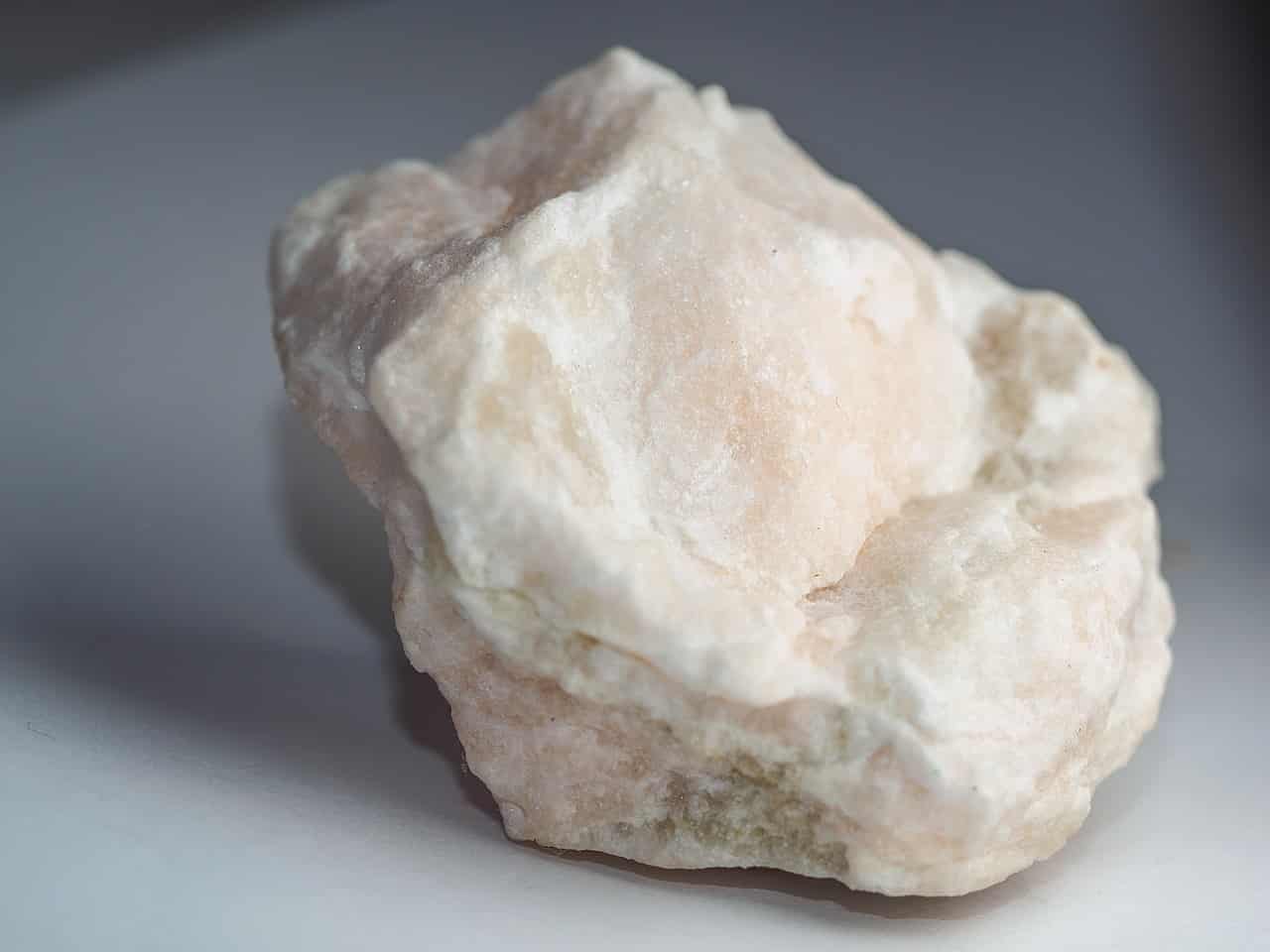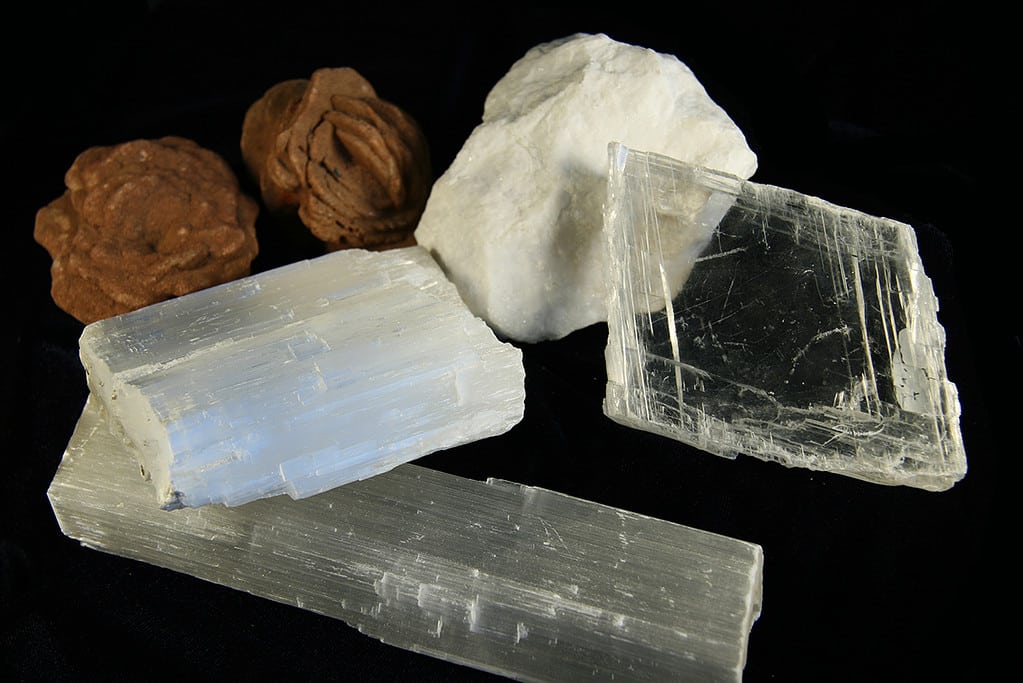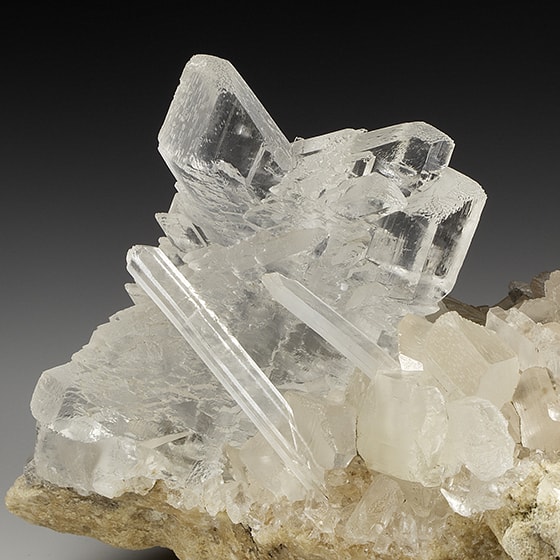
Gypsum is a soft sulfate mineral composed of calcium sulfate dihydrate (CaSO4·2H2O). It is renowned for its wide use in the manufacturing of plaster, drywall, and fertilizers. The mineral forms in geological time from the evaporation of water (it’s an evaporite mineral) and as a hydration product of anhydrite. It’s a versatile and widespread mineral, pivotal in various industries ranging from construction to agriculture as well as in geological research.
How Gypsum Forms
Gypsum formation primarily occurs in sedimentary environments. The main ways this type of mineral forms involve the evaporation of seawater or the precipitation from groundwater. Both processes highlight the mineral’s connection to water.
In fact, from its very chemical chemistry you can tell that it contains water (the H2O part) in addition to the calcium (Ca) sulfate (SO4).
Evaporation of Seawater
It all starts in shallow saline bodies of water, such as seas and salt lakes. In this environment, evaporation can lead to the supersaturation of minerals, among which gypsum is one of the first to crystallize.
As the seawater evaporates, it leaves behind increasing concentrations of dissolved minerals. Gypsum precipitates out of the solution when the concentration of calcium and sulfate ions reaches a critical point. This sequence of precipitation, known in geology as evaporite formation, often occurs in massive deposits alongside other evaporites like halite (rock salt) and anhydrite.
Groundwater Precipitation
Groundwater carrying dissolved ions from evaporite rocks can precipitate gypsum under the right conditions. As this mineral-rich water percolates through soil and rock, it may encounter environments that trigger the crystallization of gypsum. This is common in arid and semi-arid regions where groundwater evaporates at or near the surface, leaving behind crystalline deposits.
Additionally, the interaction of sulfide minerals with oxygenated groundwater can produce sulfuric acid, which then reacts with calcium-bearing minerals to form gypsum.
Hot Springs and Fumaroles
Hot springs and fumaroles (volcanic gas vents) provide another unique setting for gypsum formation. In these environments, volcanic gases rich in sulfur dioxide can oxidize to sulfuric acid upon contact with atmospheric oxygen. The acid then reacts with calcium-rich rocks or groundwater to precipitate gypsum. This process is evident in areas with volcanic activity, where gypsum forms as sinter around hot springs or as encrustations near fumaroles.
Cave Environments
In limestone caves, gypsum can form as a secondary mineral through the reaction of sulfuric acid with calcite, the primary component of limestone. This acid can originate from sulfide minerals in the surrounding rock or from acid rain percolating through the soil. The resulting gypsum often appears as speleothems (cave formations) such as crystals on walls and floors, or as intricate formations like the renowned “desert roses.”
Synthetic Formation
Apart from natural processes, gypsum is also produced synthetically in various industrial processes. One common method is through flue-gas desulfurization in power plants, where sulfur dioxide is removed from exhaust gases, producing synthetic gypsum as a by-product. This synthetic variant shares the same chemical properties as natural gypsum and is used in the same wide range of applications.
Gypsum Physical and Chemical Properties

Gypsum is known for its very soft nature, scoring 2 on the Mohs hardness scale, making it easily scratchedeven with a fingernail. It is generally white, colorless, or gray, but can adopt hues of red, brown, or yellow due to impurities. Gypsum’s transparent to translucent crystals are vitreous to pearly, while its massive form exhibits a dull luster. The mineral has a white streak, good cleavage in one direction, and is soluble in water, with a specific gravity of about 2.3. Let’s take a closer look.
Chemical Composition
Gypsum is a hydrated calcium sulfate mineral with the chemical formula CaSO4·2H2O. The mineral is made of calcium (Ca), sulfur (S), oxygen (O), and water (H2O). The presence of water within its crystal structure is particularly noteworthy, as it allows gypsum to undergo a reversible reaction where it can lose water to form anhydrite (CaSO4) upon heating and reabsorb water to revert back to gypsum.
Color and Transparency
Gypsum’s color typically ranges from white to colorless in its pure form, making it easily identifiable. However, the presence of impurities can give gypsum a range of colors, including pink, yellow, blue, or even gray. This variability adds to its aesthetic value, especially among collectors and decorators. The mineral’s crystals can be transparent to translucent, with the transparency level often influenced by the amount and type of impurities present.
Hardness and Cleavage
With a Mohs hardness of 2, gypsum is very soft, allowing it to be scratched easily with a fingernail. This softness is a defining characteristic and is utilized in its identification. Gypsum also exhibits good cleavage in one direction and fair cleavage in two others, enabling it to be split into thin sheets or rhombic fragments. This cleavage, combined with its softness, makes gypsum highly workable for various applications.
Luster and Streak
Gypsum’s luster varies depending on its form. Crystals exhibit a vitreous (glass-like) to pearly luster, making them appealing for ornamental and decorative purposes. The massive form of gypsum, which is more common in industrial applications, tends to have a dull luster. When rubbed across a streak plate, gypsum leaves a white streak, regardless of the color of the gypsum sample itself. This characteristic is consistent among all forms of gypsum.
Specific Gravity and Tenacity
The specific gravity of gypsum is approximately 2.3, indicating it is relatively light among minerals. This low specific gravity is due to the water content in its structure and its overall molecular arrangement. Despite its softness, gypsum exhibits a certain level of tenacity. It is flexible but inelastic, meaning it can bend under force but does not return to its original shape.
Solubility and Reactivity
Gypsum is moderately soluble in water, more so at room temperature and less so as the temperature increases—a property known as retrograde solubility. This solubility plays a significant role in how gypsum is processed for use in various industries. Furthermore, gypsum’s reactivity with hydrochloric acid (HCl) is a notable chemical property, as it can dissolve in hot, dilute HCl, making it distinct from minerals with similar appearances but different chemical compositions.
Optical Properties
Optically, gypsum is biaxial (+), with refractive indices that provide it with a unique brilliance when cut and polished for gemstone use or decorative objects. The mineral’s birefringence (difference in refractive indices) contributes to its sometimes silky or pearly appearance, especially in fibrous varieties.
Gypsum Occurrence

Gypsum is a common mineral, forming thick and extensive evaporite beds associated with sedimentary rocks. It is deposited from lake and sea water, hot springs, volcanic vapors, and from sulfate solutions in veins. Unique conditions in places like the White Sands National Park in New Mexico have created vast expanses of white gypsum sand, showcasing the mineral’s ability to form under various environmental conditions.
- Sedimentary Basins: Gypsum forms extensive evaporite beds in sedimentary rock layers, primarily through the evaporation of seawater or saline lakes, making these areas prime targets for gypsum mining.
- Marine and Lake Environments: Gypsum precipitates from evaporating seawater or lake water, leading to large deposits, such as those in the White Sands National Park, USA.
- Caves: It can form as a secondary mineral in limestone caves through reactions between sulfuric acid and limestone, creating unique speleothems like selenite needles.
- Industrial Byproducts: Synthetic gypsum is produced from flue-gas desulfurization in power plants, offering an additional source of this mineral.
- Volcanic Areas: Around fumaroles, gypsum can precipitate from volcanic gases reacting with groundwater.
Gypsum Uses

Historically and contemporarily, gypsum has been utilized in numerous applications.
- Construction: Gypsum is a primary ingredient in plasterboard or drywall, enhancing fire resistance and insulation. Its thermal properties and ability to harden when mixed with water make it ideal for constructing walls and ceilings.
- Agriculture: As a soil conditioner, gypsum improves soil structure, aeration, and water retention. It supplies sulfur and calcium, essential nutrients for crops, without altering soil pH.
- Art and Sculpture: Historically, gypsum, in the form of alabaster, was used for sculpture due to its softness and workability. It remains popular for decorative items and in art for casting molds.
- Industrial Applications: In the manufacture of cement, gypsum acts as a set retarder, preventing concrete from hardening too quickly. It’s also used in water treatment and as a filler in products like toothpaste and paints.
- Medical Field: Gypsum’s role extends to the medical field, where it is used for making dental and orthopedic casts.
Facts About Gypsum
Gypsum has been used since ancient times, with its name derived from the Greek word “gypsos,” meaning plaster. Notably, gypsum’s role in history extends to its use in sculptures by ancient civilizations and as window panes in Greek temples before the invention of glass. The mineral’s ability to harden when mixed with water led to the term “Plaster of Paris,” owing to the large deposits found in the Paris Basin.
- Gypsum has been utilized since ancient times. The Egyptians used alabaster, a form of gypsum, for sculptures and monuments, while the Greeks used selenite crystals as windows in their temples before the invention of glass.
- The water molecules within gypsum’s crystal structure release as steam when exposed to heat, helping to control the spread of fire in buildings. This property makes gypsum-based materials like drywall essential for providing fire protection in modern construction.
- Gypsum’s presence in sedimentary layers can indicate past environmental conditions, such as the evaporation of ancient seas or lakes, offering valuable insights into Earth’s history.
- Gypsum can form unique, rose-like structures known as “desert roses” in arid conditions. These formations are created by the combination of water, wind, and sand, encapsulating gypsum crystals in a distinctive, flower-like appearance.
- Unlike many minerals, gypsum can be synthetically reproduced in industrial processes, making it a sustainable material for construction and other applications.
FAQ about Gypsum
- What makes gypsum unique?
Gypsum’s capacity to lose and regain water makes it uniquely useful for producing plaster and plasterboard, essential for construction and agriculture. - Is gypsum safe to handle?
Yes, gypsum is non-toxic and is even used as a food additive. However, powdered gypsum can irritate the skin and mucous membranes in its dust form. - Can gypsum be found everywhere?
While gypsum is a common mineral, its deposits are more abundant in specific geographic locations known for evaporite and sedimentary rock formations. - How does gypsum benefit the agriculture sector?
Gypsum acts as a source of sulfur and calcium for plant growth without affecting soil pH, making it a valuable soil amendment and fertilizer.






